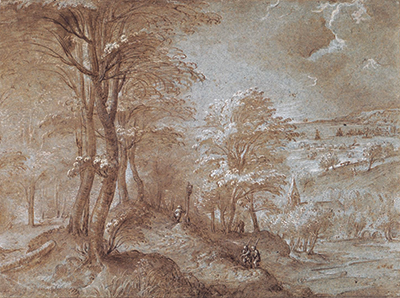This complex landscape drawing was completed in 1554 by Pieter Bruegel the Elder, many years before the family dynasty would pass on to his sons.
He constructed it using ink and wash with some additional touches of chalk in order to add depth to certain parts of the composition. There was also some touches of opaque watercolour as well, though we would still class this piece as essentially a drawing using the techniques of the 16th century. It is believed to have made it's way to the Harvard Art Museums via The Maida and George Abrams Collection. There is a greater level of precision and completeness to Wooded Landscape with a Distant View toward the Sea than see in many of his other drawings. The trees, for example, are beautifully finished with a variety of light which leaves great detail behind, even though the palette is just so restricted. This piece would not have been suitable for engraving because of the different techniques that he used, particularly with the wash and touches of chalk.
The composition features several tall trees in the foreground, to the left hand side as we look at it. They fill the vertical balance of the artwork, allowing a sense of perspective. All significant detail is then placed on the right of them, essentially making them the framing tools of this piece. Bruegel did this regularly, but would only have do so on one side or the other, never on both. You will see the same in some of his prints which derived from engraved artworks which made use of the skills of some of his colleagues in the Netherlands and Belgium. A further tree is placed directly in the centre of the drawing, though with light adorned upon it. Further back the land falls away to allow the piece to breathe, with a small collection of buildings and a more sparse selection of trees and shrubs.
This piece is now owned by Harvard Art Museums in the United States. They possess a large amount of classical art alongside a good amount of antiquities from all across the world with which students and the public alike can learn from the rich history of art. Many of these items will actually help us to learn more about particular civilisations as well, making them much more than just pretty things to look at when we have a spare moment. The institution is well backed and able to continue to grow this impressive collection which holds something for pretty much every taste. In terms of specific paintings related to European art, you might like to locate the likes of Red Boats, Argenteuil by Claude Monet, Self-Portrait Dedicated to Paul Gauguin by Vincent van Gogh and The Rehearsal by Edgar Degas when visiting this series of buildings and departments.




